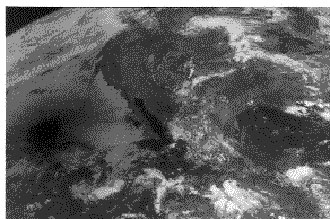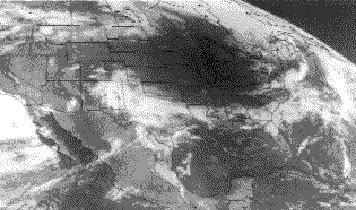|
Observe Eclipses!
|
Solar Eclipse Observing--Environmental StudiesIntroduction. In the fifteen–or–so minutes on either side of totality or annularity, subtle changes take place in the environment and in the behaviors of wildlife. Family members without extensive astronomical equipment or projects to conduct can make valuable contributions as observers of their physical and biological surroundings. Pinhole camera images. As the sun dwindles to a thin crescent and the ground lighting dims, hundreds of tiny images of the crescent sun appear projected among the shadows cast by leaves beneath their trees. Nature produces this fascinating phenomenon in much the same fashion as observers who make pinhole camera viewing devices; in this case, the pinholes are the tiny spaces between the densely packed leaves. A worthwhile experiment for even young children would be to try out a variety of manufactured and home–made devices to determine what apertures produce the clearest and sharpest pinhole images. Some recommended household items are colanders, sifters, strainers, squares of pegboard and perforated convection–oven trays. Even the fingers of their own hands, spread slightly apart, will project these crescent shapes. They might also be alert to the types of trees and leaves, or other foliage, which produce the best natural images. Diminishing light. As the sun dwindles to a smaller and smaller crescent, the surrounding landscape very gradually takes on a late–afternoon appearance. In the final minutes before totality, however, the changes in lighting become quite striking, and the skylight seems to diminish in stepped increments rather than with a smooth, gradual transition toward darkness. The changing colors of the surrounding landscape and distant clouds can be quite striking as well, with yellows and oranges most often described. Nor do light intensity and color changes necessarily mirror themselves coming out of totality. Many describe the sun’s return as abrupt and the colors less pronounced or of different hues following totality, while others believe these perceptions to be more psychological in origin; certainly, further investigation is warranted. Artists and poets have a distinct advantage over photographers and technocrats in capturing diminishing–light phenomena and the feelings that accompany them. Wildlife behaviors. Animals are very perceptive to changes in their environment. Their responses to the unexpected early nightfall and even more unexpected daybreak after such a short night, can make a fascinating study. Livestock, wild birds, squirrels, insects and even domesticated pets will behave in unusual and interesting ways because of the environmental changes that accompany a total or dark annular solar eclipse. Some animals, accustomed to feeding schedules dictated by dawn and dusk, exhibit changes in eating habits on eclipse day and, according to some reports, for several days after an eclipse. Others, roosters, for example, crow on cue as twilight comes and goes, and appear to experience no disorientation at all. Mosquitoes have been known to go on feeding frenzies, and even aquatic life is not spared; fish are reportedly more willing to bite around totality (if one can imagine taking time out from such a celestial spectacle to go fishing), and their neighboring amphibians have been heard to carry on quite loudly. Studies of solar eclipse effects on individual forms of wildlife, except for occasional anecdotal accounts of diminished milk production by cows and egg production by chickens, are few at best. People with interests in these areas are encouraged to pursue them. Meteorological observations. Most eclipse–chasers have at least a basic familiarity with meteorology and weather forecasting. Many amateur astronomers carry along meteorological instruments to measure temperature, wind, air pressure and humidity changes throughout an eclipse. For others, a primary reason for observing the eclipse may be meteorology. There are significant changes in the weather during eclipses. As the amount of sunlight is reduced, the temperature of the surrounding air begins to fall. This results in corresponding changes in the barometric pressure, wind speed and direction, dew point and humidity. These changes can sometimes result in unexpected fog or dew formation that can hinder eclipse observations and photography; they should be anticipated and equipment should especially be monitored for dew formation if the relative humidity is high. A simple grade–school experiment can quickly determine the dew point at an observing site prior to totality. Slowly add a few shards of ice, a little at a time, to a glass or metal container of water. The moment a thin mist of dew forms on the outside of the container, insert a thermometer into the water. The water temperature at that moment is the dew point of the surrounding air, or the temperature at which dew and fog will form. If the air temperature is sufficiently higher, you should have no problem with dew; if it is within five degrees or so, it would be wise to monitor your equipment carefully. Recording readings from meteorological instruments are good projects for younger family members or those without astronomical observations to conduct, and are excellent additions to your eclipse journal. Instruments to consider taking are thermometers, barometers, hygrometers, anemometers (simple hand–held wind–speed devices are available from most science supply houses), and compasses for determining wind direction. If your site is near an airport or television station, consider making prior arrangements with the resident meteorologists to allow you to stop by after the eclipse and photograph their chart recorders or copy their data for the various weather elements. Some will also have instruments which record sunlight intensity throughout eclipse day. An interested researcher or astronomy group might wish to query weather stations all along the eclipse path to obtain comparative data. Weather satellite imagery. Many schools and amateur meteorologists have access to inexpensive groundstation equipment capable of receiving real–time U.S. NOAA and Russian Meteor satellite images on their personal computers. Local HAM radio clubs or weather stations may be able to put you in contact with them.
If a satellite pass coincides with the time of totality, the moon’s shadow on the earth’s surface (or on cloud tops) should be visible in the image received. Stored in their computers as TIFF (Tag Image File Format) files, they may be easily copied onto 3.5–inch high–density microdisks and transferred to your own hard drives for viewing later. Service bureaus, desktop publishing companies and photo processors in major metropolitan areas can provide photographic prints from these computer files. The original NOAA images, incidentally, contain both visible and infrared frames side–by–side; the latter may be processed, through the system’s software, to provide remote temperature readings within the moon’s shadow. Following the eclipse, weather satellite imagery of the moon’s shadow might also be found on computer bulletin board systems (BBS’s) as GIF (Graphics Interchange Format, pronounced JIF) files that may be downloaded by modem to your own hard drive or high–density microdisk and viewed with the appropriate software. Most computer desktop publishing and painting software supports TIFF files (identified by the suffix .TIF). GIF files (.GIF) save and retrieve slower than TIFF files, but use an efficient compression algorithm which keeps file size small and saves disk space, making them a favorite for BBS’s and for more rapid uploading and downloading. Photographic projects. A light–colored surface, such as the side of a house, a street, sandy ground, bed sheet, or piece of white cardboard, will make the leaf–formed pinhole camera images of crescent suns stand out for photography. Still or video available–light photographic sequences, at fixed aperture and shutter speed, would be useful in determining when these images are first and last visible on each side of totality or annularity. Photography of diminishing light effects may be attempted, especially with low–light video cameras. Also, don’t neglect photographic studies of wildlife behaviors and photo documentation of chart recordings from weather instruments.
|

